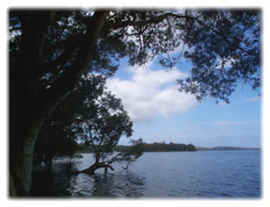The Buladelah-Taree Holiday Song Cycle was one
of the first works by Les Murray that achieved national acclaim. It is based on Australian
Aboriginal patterns for poetry and also shares with the Aboriginal worldview a
spirituality of place and time. It is set during the season leading up to Christmas, which
in Australia is summer. Its 13 sections deal broadly with the following:
- The north country; its town people living in an era of rationalized
farming; the return of families to old homesteads.
- The commute along the highway ("the Long Narrow City") and
their return to the region.
- The snakes and ducks offer a "relearning [of] that
country."
- The birds and their places; Deer's Hill.
- The distance between the Fathers and the young; the differences in
their ways of approaching the world. (Murray's own relationship?)
- Holiday goings-on--barbecues, children, dogs, boats.
- Children or lovers among the corn at various times of day.
- Mosquitoes and their nesting.
- Aboriginal warriors and their attitudes towards the whites.
- The Ibis upon the wetlands
- Old fruit trees; mothers, memories.
- Heat and sun and summer storms.
- Constellations
Of course, this is to treat the delicacy of his observations with a
sledgehammer. What is really going in is a sense of being within the life cycle of things,
as a form of consciousness, but even better said, a sense of embodiment. Murray is
offering us again an experience of grace.
Questions
- How would you characterize the style of this poem? Name some
examples.
- Compare and contrast the world of the old (those who have stayed) and
the world of the young (those who have returned).
- What is the relationship in the poem between humans and the rest of
the world?
- How do the Aboriginal peoples view the others?
- How spatially and temporally does the poem place the narrative
observer?
- Why does he end the poem with the constellations?
- Why is this poem beautiful? What does it reveal about human life and
our place in the world?
|
